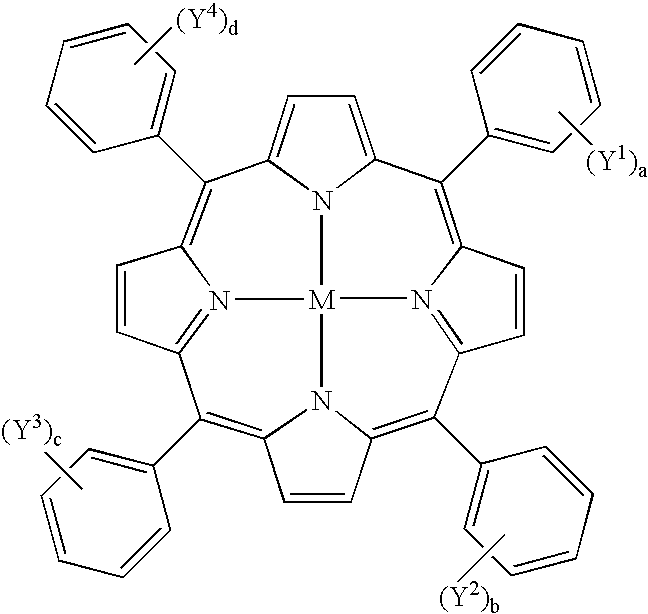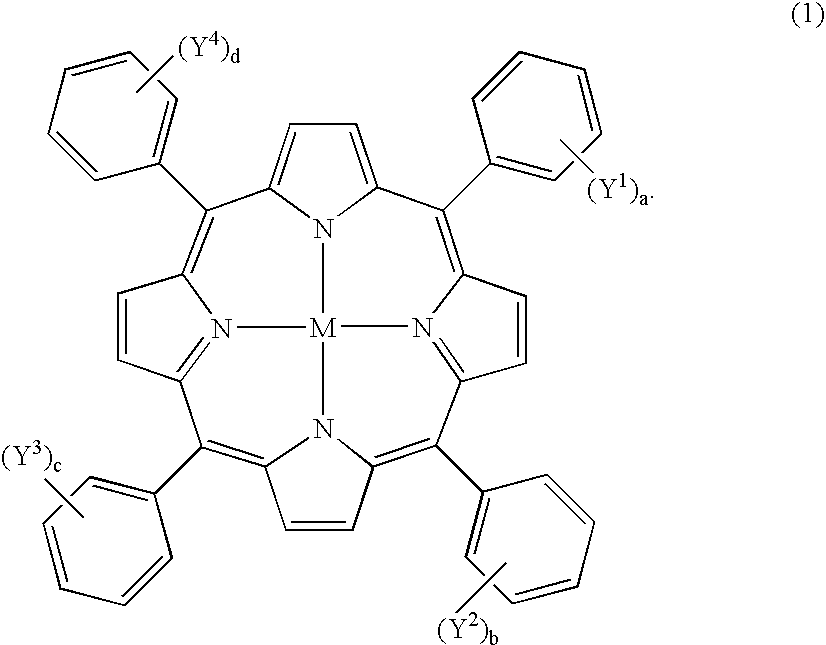Symmetric and Asymmetric Halogen-Containing Metallocarboranylporphyrins and Uses Thereof
- Summary
- Abstract
- Description
- Claims
- Application Information
AI Technical Summary
Benefits of technology
Problems solved by technology
Method used
Image
Examples
example 1
Synthesis of 3,5-Dipropargyloxybenzyl alcohol (I)
[0084]Finely powdered K2CO3 (14 g, 0.10 mol), and KI (17 g, 0.10 mol) were stirred in acetone (200 mL) under a nitrogen atmosphere. 3,5-Dihydroxybenzyl alcohol (4.2 g, 0.030 mol), and propargyl chloride (5.3 g, 0.071 mol) were added and mixture was allowed to reflux overnight. After the solution was filtered, and evaporated down to dryness, the residue was diluted with DCM, worked up and the solvents were removed in vacuo leaving a yellow oil, which solidified upon standing to give 6.3 g in 97% yield.
[0085]The product had a melting point of 79-80° C. and gave the following proton nuclear magnetic resonance (1H NMR) spectrum in ppm (in CDCl3 solvent): 2.52 (t, 2H, C≡CH); 2.15 (br s, 1H, OH); 4.65 (d, 4H, ArOCH2); 4.60 (s, 2H, ArH2); 6.52 (s, 1H, ArH); 6.60 (s, 2H, ArH). The product gave the following proton-decoupled 13C NMR spectrum in ppm (in CDCl3 solvent): 56.1 (ArOCH2); 65.1 (ArCH2); 75.9 (C≡C); 78.6 (C≡C); 101.6 (ArC); 106.4 (ArC...
example 2
Synthesis of 3,5-Di(propargyloxy)benzyl acetate (II)
[0086]3,5-Dipropargyloxybenzyl alcohol (I) (6.3 g, 0.029 mol) was stirred in acetic anhydride (7 mL, 0.07 mol). Concentrated sulfuric acid (2 drops) was added and the solution was stirred (90-100° C.) for 3 hours. The solution was then poured into ice water, neutralized with a saturated sodium carbonate solution and after the reaction was worked up, the product was purified using silica in a sintered glass funnel and the solvents were removed leaving a yellow oil, which solidified upon standing, 7.2 g in 96% yield.
[0087]The product had a melting point of 65-66° C. and gave the following proton nuclear magnetic resonance (1H NMR) spectrum in ppm (in CDCl3 solvent): 2.11 (s, 3H, CH3); 2.54 (t, 2H, C≡CH); 4.67 (d, 4H, ArOCH2); 5.05 (s, 2H, ArCH2); 6.58 (s, 1H, ArH); 6.61 (s, 2H, ArH). The product gave the following proton-decoupled 13C NMR spectrum in ppm (in CDCl3 solvent): 21.3 (CH3); 56.0 (ArOCH2); 66.2 (ArCH2); 76.2 (C≡C); 78.6 (C...
example 3
Synthesis of 3,5-Di(o-carboranylmethoxy)benzyl acetate (III)
[0088]Decaborane (2.70 g, 0.022 mol) was dissolved in dry toluene (80 mL) and stirred at room temperature under a nitrogen atmosphere. Anhydrous acetonitrile (12 mL, 0.22 mol) was added and the solution was stirred for 3 hours. A solution comprised of 3,5-di(propargyloxy)benzyl acetate (II) (2.84 g, 0.011 mol) in toluene (80 mL) was added to the decaborane solution and the mixture was heated to 80-90° C. and was maintained at this temperature for 3 days, after which time the results from analytical thin layer chromatography (TLC) showed no presence of starting material. The excess decaborane was decomposed by the slow addition of methanol (20 mL) while cooling in an ice-water bath. After the solvents were removed by rotary evaporation the resulting residue was dissolved in DCM, washed with 10% sodium bicarbonate, water, dried over anhydrous sodium sulfate and the solvent was removed by rotary evaporation, leaving a yellow o...
PUM
| Property | Measurement | Unit |
|---|---|---|
| Electric dipole moment | aaaaa | aaaaa |
| Mass | aaaaa | aaaaa |
| Mass | aaaaa | aaaaa |
Abstract
Description
Claims
Application Information
 Login to View More
Login to View More - R&D
- Intellectual Property
- Life Sciences
- Materials
- Tech Scout
- Unparalleled Data Quality
- Higher Quality Content
- 60% Fewer Hallucinations
Browse by: Latest US Patents, China's latest patents, Technical Efficacy Thesaurus, Application Domain, Technology Topic, Popular Technical Reports.
© 2025 PatSnap. All rights reserved.Legal|Privacy policy|Modern Slavery Act Transparency Statement|Sitemap|About US| Contact US: help@patsnap.com



